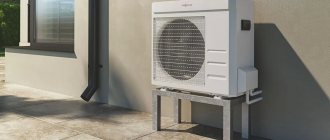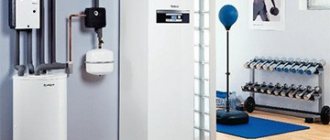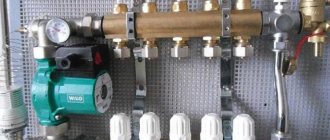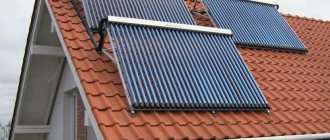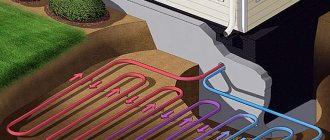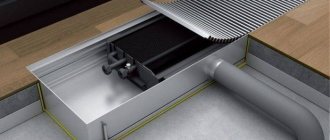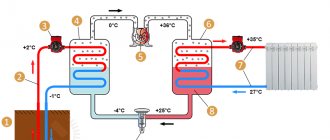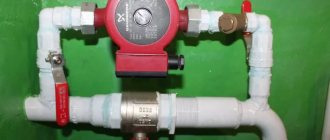For heating and providing hot water to private homes, it is advisable to use a water-to-water heat pump powered by natural sources - groundwater, rivers, reservoirs, etc. The system is absolutely environmentally safe and does not require regular costs for consumables, which is why it is becoming increasingly in demand.
We will talk about options for a heat pump that uses eco-energy from water to transfer it to household heating systems. For inquisitive home craftsmen, we have described the operating principles of popular device options and construction technology. Here you will find out what equipment is required for the system to operate.
Operating principle of a water-to-water heat pump
The heat pump embodies the principle of the Carnot cycle. It lies in the fact that a substance moving through a closed system and changing its state of aggregation from liquid to gaseous under the influence of chemical, physical or thermal factors releases and absorbs a huge amount of thermal energy.
The working substance is a thermal carrier - water from a well or reservoir.
Even in winter, natural springs at a certain depth maintain a positive temperature, so thermal energy can be extracted from them all year round. The only drawback of the installation is the high power consumption and the need to purchase additional equipment.
The diagram shows the circulation path of water and refrigerant. The system allows you to receive thermal energy, regardless of the season
The main elements of a water-to-water heat pump:
- compressor;
- evaporator;
- capacitor;
- expansion induction valve;
- automatic system that monitors indicators;
- multiple lines of copper pipes;
- working substance (refrigerant).
Using a special pump, water flows through tubes from the source to the heating unit, after which it interacts with gas (freon), which boils at a temperature of +2-3 degrees. Freon absorbs some of the heat from the water and is sucked into the compressor, where its temperature rises during compression.
Heat pump equipment takes up a lot of space, but provides an opportunity to get rid of utility dependence
Next, the refrigerant enters the condenser, after which the hot substance heats the water to a given temperature (from +40 to +80 degrees), which is transported through the pipes of the heating system.
Cooled water enters the evaporator and then drains into the receiving well. After passing through the condenser, the refrigerant becomes liquid and collects at the bottom of the element, then returns through the throttle to its original location. Then the cycle repeats.
Image gallery
Photo from
The essence of the water-to-water heat pump
Geothermal system indoor unit
Compact heat pump for a private home
Economical heating arrangement
Useful tips
At all stages of building a house, starting from the design stage, we must remember that the HP is an inertial system. It can be compared to a massive Russian stove, which was usually heated once a day during cooking. Then the accumulated heat warmed the home until the next morning.
Walls made of heavy logs have a fairly high degree of thermal inertia. Simply put, they cool down slowly when it gets colder at night. Good thermal inertia for thick stone walls, as well as for heavy concrete or brick.
Polystyrene foam and foam concrete have good thermal insulation properties. But due to their low specific gravity they have low thermal inertia. A heater in a building with walls made of such materials, when the outside air temperature sharply drops, will not always be able to “pump” enough heat from outside into the “warm floor” heating system.
Other factors must also be taken into account:
- To reduce heat loss or avoid freezing of pipes in the main between the house and the wells or collector, it is necessary to lay them to a depth below the freezing level. In Crimea - 0.75 meters is enough, and at the latitude of Moscow - at least 1.5.
- The greatest heat loss is usually through windows. Therefore, triple glazing is not a luxury at all, but an economically sound construction solution. The ideal option is to use glass that can reflect infrared rays.
- In the case of using the option of 2 wells for collecting and draining water, the distance between them must be at least 20 meters.
- It is better to try a homemade TN first in a utility room or garage. Installing heated floors in a residential area will require additional costs. Find out the order of the corner fireplace by following the link.
What to look for when arranging such heating?
There are a large number of different modifications of heat pumps designed for premises of any purpose and size, as well as operating in different conditions. The equipment is intended for heating houses with a total area of 50 to 150 square meters.
Guideline No. 1 - water hardness
The water quality of a well or reservoir plays an important role when choosing equipment. Not all models are able to work on hard water containing large amounts of manganese and iron.
A high concentration of these elements harms the system - corrosion forms on the pipes faster, which leads to a decrease in the efficiency of the equipment and its service life.
Therefore, before purchasing a heat pump, they take a water sample and analyze it for the presence of these and other microelements - hydrogen sulfide, ammonia, chlorine, etc. Usually, if the temperature in the pond exceeds +13 degrees, then there is a high probability that there are a lot of iron and manganese ions in the water.
Thus, the water-to-water heat pump is selected taking into account the water hardness. There are systems whose elements are maximally protected from corrosion, but they are more expensive.
Guideline No. 2 - operating mode
The heat pump can be used as the sole heat source or in conjunction with other systems. Therefore, before choosing a model, it is important to determine in which mode the device will operate.
There are two types of system operation:
- Monovalent. The devices have great power and are suitable for heating a home.
- Bivalent. Less efficient devices complement the main heating equipment.
To build an autonomous system with a main water-to-water heating unit, you need a monovalent type.
Guideline No. 3 - pump power
Power is an important indicator when choosing a heat pump, since the performance of the system depends on it. The higher the power, the higher the efficiency of the equipment, but the higher the energy consumption.
The performance of the water-to-water heat pump is selected based on real needs
If you choose a device with insufficient power, the efficiency of the system will decrease if the heat loss in the house exceeds the amount of energy supplied by the system. The heat pump can operate around the clock, but it will have no effect due to the drop in water temperature.
When the heat loss of a building is lower than the heat transfer of the system, the pump usually automatically starts for a few minutes, heats the water to the set temperature, and transports it through the system. Then it turns off until the temperature drops a few degrees. Then the cycle repeats.
Guideline No. 4 - functionality of a specific model
Heat pumps may have additional functions, these are:
- An automatic control system that will allow you to adjust the microclimate of the room to your taste. Control is usually carried out using a remote control.
- Water heating function for hot water supply.
- Soundproof housing.
- Possibility of connection to other heating systems, solar collectors, which will make the heating equipment completely autonomous.
The service life of water-to-water heat pumps usually exceeds 30 years.
Equally important when choosing equipment is the cost of installation and assembly.
Efficiency
Over time, the profitability of HP becomes more and more obvious due to the constant increase in the cost of energy resources. Technology also does not stand still.
Programmable control circuits for home appliances with remote access no longer surprise anyone. The heat pump is seamlessly integrated into the smart home system, which reduces equipment wear and extends its service life.
A properly selected and high-quality installed heat pump is a guarantee of providing heat regardless of the time of year and market fluctuations in energy prices.
But a heat pump can achieve maximum efficiency if you decide on the choice of heating system at the early stages of building design. Then it is possible to choose the optimal materials and thickness of enclosing structures with the required thermal conductivity and thermal inertia.
Calculation of the required heat pump power
Before purchasing a system, it is important to first draw up a project and calculate the required equipment power. Productivity is calculated taking into account the actual needs for thermal energy. Heat consumption, heat loss at home and the presence or absence of a DHW circuit are taken into account.
Calculation algorithm:
- We calculate the total area of heated premises.
- We determine the required amount of energy for heating. The optimal indicator per 1 square meter is 0.07 kW.
- To heat a house of N square meters, you will need N*0.07 kW.
- For hot water supply, an additional 15-20% is added to the resulting number, that is, N*0.07*0.85 or N*0.07*0.80.
This calculation will be optimal for rooms with ceilings not exceeding a height of 2.7 m. More accurate calculations will be made by specialists during the preparation of the project.
Image gallery
Photo from
Interior of a water-to-water heat pump
Where is it profitable to install a water-to-water heat pump?
Efficient equipment with economical energy consumption
Heat pump heat exchanger in the hallway
Review of manufacturers
Installation costs, taking into account the cost of wells, can range from 5 to 10 thousand dollars. When using an open reservoir it will be 1.5-2 times cheaper.
Manufacturers of heat pumps are divided into three price categories:
- Cheap Chinese ones. For example, Meeting (China), maximum power - 7 kW, heated area - 50-100 m2, price - 95,200 rubles.
- They are produced under the American brand in China. For example, Mammoth (USA/China), maximum power - 7.8 kW, heated area - 50 m2, price - 261,000 rubles.
- The most expensive ones are traditionally German. For example, Stiebel Eltron (Germany), maximum power - 9.9 kW, heated area - 50 m2, price - 645,000 rubles.
It is recommended to choose an operator that provides a full range of services:
- design;
- supply;
- installation;
- commissioning works;
- service maintenance.
Prices for different heat pump models
Heat pump
Preparatory work before operation
Preparation for assembly, connection and commissioning of a heat pump from the water-to-water series includes a number of standard steps, which we will get acquainted with later.
Choosing the optimal water source
It should be noted that not every open source or water well is suitable for the uninterrupted operation of a heat pump. Water quality plays an important role, but filters will help solve the problem of contamination.
It is permissible to use a reservoir or pond located within a radius of 100 meters from the building. If there is no such source, then the need to drill wells arises.
The choice of source for a heat pump should be based on ease of use and cost of use. If there is a nearby open reservoir, it is wiser to use it
The behavior of an open source is more predictable than groundwater, so if possible, it is better to give preference to reservoirs.
Image gallery
Photo from
Geothermal well for heat pump
Inexpensive heat pump evaporator option
Connecting the evaporator pipes to the heat exchanger
Evaporator pipes are prepared for inspection
Installation of a thermal system using a well
To install a system using a heat pump, you will need two wells. One of the wells is usually called debit. It is into this that a special pump is immersed, with the help of which water is taken for subsequent processing in the system. The second well is a receiving well. Cooled water is drained into it.
The drain and supply wells must be located at least 15 meters apart from each other.
The depth of the debit well should not exceed 50 meters. The deeper the water source is, the more powerful the pump required to supply it, which will increase the amount of energy consumed.
Construction of a debit well
Before starting to operate a debit well, it is important to find out how much water it can produce and how much liquid is needed to provide heat to the entire room. The higher the water temperature, the less it will be needed for heating.
It is important to pre-calculate the volume V that needs to be pumped out of the well within an hour to heat the room. Let's say there is a pump whose heat output is equal to a certain number Q kW, and the power consumption is equal to a number P kW. You will also need to find out the temperature of the groundwater ( t1 ) and its temperature after temperature exchange ( t2 ).
Then the formula for calculating the volume of the required amount of water per hour looks like this:
V = (QP)/(t1-t2).
It is analytically impossible to determine the ability of a debit well to produce the required volume of water, so it is tested. For 3 days, the pump uninterruptedly pumps water from the well. In this way, the receiving well is also checked for its ability to receive the required amount of water under high load.
It is important to understand that groundwater behaves unpredictably, so the amount of water from a debit well may become less over time. For example, in spring there are high tides, but in winter, on the contrary, the water decreases. If there is not enough water in the well, the system automatically turns off and heating does not occur.
Features of the receiving well
The receiving tube well is located downstream of the groundwater. It is analytically impossible to determine in which direction the water is moving. Therefore, in practice, an arbitrary well is selected as a debit well and a submersible pump is launched into it.
If the water level does not drop during operation of the system, then the choice was made correctly. If the level has dropped and the water temperature has dropped, then it is necessary to swap the wells - move the submersible pump to another hole.
The drain pipe into the receiving well must be immersed a few centimeters in water, without reaching the bottom. If you dump waste liquid from above, it will lead to waterlogging. The tube well may stop receiving water and become clogged.
The result threatens overflow, and in winter, possible icing. The best options for a receiving source are a river or pond. If these objects are not nearby, then there is a need to drill one or more receiving wells in order to insure against overflow.
The figure shows an example of using one well as a receiving and debiting well
It is impossible to find out whether a well will receive water either analytically or by testing. Practice shows that a drain well can uninterruptedly absorb water for many years, or it can completely fail in one season.
There are technologies that allow you to use one well as a debit and a receiving well, but this method is not effective - operation will be accompanied by difficulties, a decrease in water temperature, waterlogging and a number of other problems are possible.
Design of a system using a reservoir
The selected pond must be deep enough so that the lower layers of water do not freeze during severe frosts. In the Southern regions, the optimal depth will be approximately 1 meter; in the Northern regions, a source with a depth of 3 meters will be required. Also, the pond must be stable - fluctuations in the water level and its decrease are unacceptable.
There are two pipelines to the reservoir - debit and receiving. A submersible pump is installed in the receiving area
It is recommended to use HDPE models as pipes, which are characterized by durability and reliability. It is important to protect pipes from freezing by additionally insulating them, and from breakthroughs.
Preparing your home for a heat pump installation
To interact with a water-to-water heat pump, the house must be equipped with a water-based heating system, presented in the form of pipes and radiator batteries. For better insulation, it is also permissible to install heating pipes in the floor and walls.
If the equipment will be used to supply hot water, then the house must have a collection system. To operate the pump, you need to be connected to an electrical network with unlimited power.
Without additional measures for thermal insulation of the house (insulation from the outside, installation of double-chamber windows, etc.), operating a heat pump makes no sense.
Experts recommend additionally installing a supply-type ventilation system with an air heating mechanism. The freon used in the equipment is harmful to humans. If micro-ruptures occur in the system circuit, the gas will be released and thereby displace air from the room. The refrigerant can cause exacerbation of lung diseases and asthma attacks in humans.
A heat pump is heavy equipment, its weight can reach a ton (depending on the power and size), so in some cases its installation requires the construction of its own foundation, not connected to the foundation of the cottage.
Before installing the equipment, you need to take into account the permissible dimensions of the room and maintain the distance to the walls specified in the product passport.
Heat recovery circuits
When using the resources of reservoirs, open and closed type heat extraction circuits can be used:
- Closed-loop structures are installed on the bottom of the lake. In technical terms, such a circuit is a closed tubular loop with a liquid circulating inside, which transfers heat from the lake to the heat exchanger.
- When using an open version of the heat sink, water is taken directly from the reservoir. After the liquid passes through the heat exchanger, it is returned to the lake.
The main disadvantage of such systems is the mandatory frequent maintenance of the heat exchanger and the need to install additional elements that filter water.
If the source of heat is groundwater, then a system with wells or wells is used. The minimum number of wells is 2. The first well serves to supply water to the heat exchanger, which removes heat. A second well is needed to pump fluid back into the ground. When placing wells or wells, you need to ensure that the distance between them is more than 15 meters.
Optional equipment
Selecting additional equipment for a heat pump is a responsible task, the solution of which largely determines the long-term service life of the heating system as a whole and the absence of operational problems.
Submersible pump for wells and reservoirs
If the system uses a heat pump to supply hot water, then a device with low power can reduce the pressure in the taps. A powerful pump will solve this problem, but it consumes more energy. The minimum permissible power when operating a GSV is 1 kW.
There are many different modifications of submersible pumps. The choice is made taking into account three criteria, these are:
- The amount of liquid used for pumping (the more water has to be transported, the higher the pump power must be).
- Well depth (the deeper the well, the greater the equipment power should be);
- Well diameter (traditionally, preference is given to 4-inch shafts, since the largest number of pumps have been created for them, as opposed to 3-inch ones).
To determine the depth of the well, it is necessary to attach a weight to a rope and lower it into the shaft. The wet part of the rope will indicate the full depth of the well, the dry part will determine the distance from the beginning of the water to the surface.
The pump is immersed in the wellbore to a depth specified by the device manufacturer. Usually the technical passport indicates how many meters there should be between the water surface and the pump, the bottom of the excavation and the pump
Both universal pumps and equipment specifically designed for wells can be suitable for mines. If the mine was developed by professionals, then it is less clogged with sand, so you can safely use a universal pump.
Pumps designed specifically for wells are more expensive, but they cope well with sand and dirt and become less clogged. Universal ones are sensitive to high organic content; they must be regularly cleaned of dirt, as a result of which their service life is reduced.
Preference should be given to pumps with automation, since if the motor overheats, there is excessive blockage or there is no water in the well, they turn off on their own, as a result of which the motor does not overheat and fail.
Based on the principle of operation, there are 2 types of submersible pumps:
- Centrifugal.
- Vibrating.
For work in wells producing water in limestone, centrifugal deep models are preferable. They are sensitive to water with grains of sand and clay suspension.
If the heat pump will be connected to an open reservoir, it is better to use surface pumping equipment designed for pumping dirty water, or an inexpensive vibration device.
Heat pump intermediate heat exchanger
In heat pumps, the freon may not be cooled well enough during circulation, causing the compressor to overheat due to excessive discharge temperatures. Therefore, it is important to improve the cooling of the substance, thereby reducing the pressure in the circuits.
There is another problem that is common to all heat pumps - the refrigerant can mix with water vapor. If liquid gets into the compressor, water hammer may occur. In this case, repair or replacement of the part will be necessary. Also, water can get into the oil, and it is difficult to remove it from there.
All the problems described above are solved by installing an intermediate heat exchanger. There are three types of heat exchangers - open type, shell-and-tube and coil.
The open type modification neutralizes the liquid that gets into the freon during circulation, which minimizes the likelihood of compressor water hammer. The device features high performance with minimal power consumption.
When installing an open-type heat exchanger, it is important to select the correct size of the liquid pipeline to ensure minimal pressure compression
Properly selected pipes will neutralize the possibility of boiling liquid. In this case, the valve must have sufficient throughput so that liquid can penetrate into the device at a low pressure difference.
The shell-and-tube heat exchanger is presented in the form of a closed structure. Heat exchange occurs through the walls of the pipes, and the liquid and refrigerant in it do not mix, unlike open ones, which provides high pressure for the circulation of steam and air.
The coil heat exchanger is distinguished by the presence of a flow regulator that controls the flow of liquid freon. The size of the device directly depends on the power of the heat pump. It is necessary to select a product taking into account the functionality and the amount available. It is advisable to give preference to collapsible models.
Heat pump filters
Water from wells or reservoirs does not come in pure form. It may contain sand, dirt, various trace elements - iron, hydrogen sulfide, manganese, chlorine, ammonia, etc. Before entering the heat pump, the water must be filtered.
First of all, it is necessary to eliminate large substances - stones, sand, dirt, silt. To remove them from the water, it is necessary to install a hydrocyclone.
A hydrocyclone is a device required for rough water purification. It must be selected taking into account the pump power
Next, it is important to install filters that eliminate iron, hydrogen sulfide, manganese, and ammonia. These microelements shorten the life of the equipment and expose it to corrosion.
You can use reverse osmosis filters, softeners, iron removers and their modifications. To provide drinking hot water, you should additionally equip it with carbon filters and a UV sterilizer that destroys bacteria and viruses.
Electric generator for backup power
Heat pumps operate from the electrical network, so if there is a power outage, the house will be left without heating. It is advisable to additionally purchase an electric generator that runs on flammable substances.
It is important that the electric generator can generate the necessary power to operate the pump compressor
Making a geothermal installation
If the previous option allows you to achieve approximately double savings, then even a homemade earthen circuit will give a COP in the region of 3 (three kilowatts of heat per 1 kW of electricity consumed). True, financial and labor costs will also increase significantly.
Although a lot of examples of assembling such devices have been published on the Internet, there are no universal instructions with drawings. We will offer a working version, assembled and tested by a real home craftsman, although many things will have to be thought out and completed independently - it is difficult to put all the information about heat pumps in one publication.
Calculation of the soil circuit and pump heat exchangers
Following our own recommendations, we begin to calculate a geothermal pump with vertical U-shaped probes placed in wells. It is necessary to find out the total length of the external contour, and then the depth and number of vertical shafts.
Initial data for the example: you need to heat a private insulated house with an area of 80 m² and a ceiling height of 2.8 m, located in the middle zone. We will not calculate the heating load; we will determine the heat requirement by area, taking into account thermal insulation - 7 kW.
If desired, you can arrange a horizontal collector, but then you will have to allocate a large area for excavation work
Important clarification. Engineering calculations of heat pumps are quite complex and require highly qualified performers; entire books are devoted to this topic. The article provides simplified calculations taken from the practical experience of builders and craftsmen who love homemade products.
The intensity of heat exchange between the ground and the non-freezing liquid circulating along the circuit depends on the type of soil:
- 1 linear meter of a vertical probe immersed in underground water will receive about 80 W of heat;
- in rocky soils, the heat removal will be about 70 W/m;
- clayey soils saturated with moisture will deliver approximately 50 W per 1 m of collector;
- dry rocks – 20 W/m.
Reference. The vertical probe consists of 2 loops of pipes lowered to the bottom of the well and filled with concrete.
An example of calculating the length of a pipe. To extract the required 7 kW of thermal energy from raw clay rock, you will need 7000 W divided by 50 W/m, we get a total probe depth of 140 m. Now the pipeline is distributed into wells 20 m deep, which you can drill with your own hands. A total of 7 drillings for 2 heat exchange loops, the total length of the pipe is 7 x 20 x 4 = 560 m.
The next step is to calculate the heat exchange area of the evaporator and condenser. Various Internet resources and forums offer certain calculation formulas, which in most cases are incorrect. We will not take the liberty of recommending such methods and misleading you, but we will offer a cunning option:
- Contact any well-known manufacturer of plate heat exchangers, for example, Alfa Laval, Kaori, Anvitek and so on. You can go to the official website of the brand.
- Fill out the heat exchanger selection form or call the manager and order the selection of the unit, listing the parameters of the media (antifreeze, freon) - inlet and outlet temperatures, heat load.
- The company’s specialist will make the necessary calculations and offer a suitable heat exchanger model. Among its characteristics you will find the main one - the exchange surface area.
Plate units are very effective, but expensive (200-500 euros). It is cheaper to assemble a shell-and-tube heat exchanger from a copper tube with an outer diameter of 9.5 or 12.7 mm. Multiply the figure given by the manufacturer by a safety factor of 1.1 and divide by the circumference of the pipe to obtain the footage.
A stainless steel plate heat exchanger is an ideal evaporator option, it is efficient and takes up little space. The problem is the high price of the product
Example. The heat exchange area of the proposed unit was 0.9 m². Having selected a ½” copper tube with a diameter of 12.7 mm, we calculate the circumference in meters: 12.7 x 3.14 / 1000 ≈ 0.04 m. Determine the total footage: 0.9 x 1.1 / 0.04 ≈ 25 m.
Equipment and materials
It is proposed to build the future heat pump on the basis of an outdoor unit of a split system of suitable power (indicated on the plate). Why is it better to use a used air conditioner:
- the device is already equipped with all components - compressor, throttle, receiver and starting electrics;
- homemade heat exchangers can be placed in the body of the refrigeration machine;
- There are convenient service ports for refilling freon.
Note. Users who are knowledgeable about the topic select equipment separately - compressor, expansion valve, controller, and so on. If you have experience and knowledge, such an approach is only welcome.
It is impractical to assemble a HP on the basis of an old refrigerator - the power of the unit is too low. In the best case, it will be possible to “squeeze” up to 1 kW of heat, which is enough to heat one small room.
In addition to the external split unit, you will need the following materials:
- HDPE pipe Ø20 mm - to the earthen circuit;
- polyethylene fittings for assembling collectors and connecting to heat exchangers;
- circulation pumps – 2 pcs.;
- pressure gauges, thermometers;
- high-quality water hose or HDPE pipe with a diameter of 25-32 mm for the shell of the evaporator and condenser;
- copper tube Ø9.5–12.7 mm with a wall thickness of at least 1 mm;
- insulation for pipelines and freon lines;
- kit for sealing heating cables laid inside the water supply (needed to seal the ends of copper pipes).
A set of bushings for hermetically sealed insertion of a copper tube.
A saline solution of water or antifreeze for heating - ethylene glycol - is used as an external coolant. You will also need a supply of freon, the brand of which is indicated on the nameplate of the split system.
Assembling the heat exchange block
Before starting installation work, the outdoor module must be disassembled - remove all covers, remove the fan and the large standard radiator. Disconnect the solenoid that controls the reversing valve if you do not plan to use the pump as a coolant. Temperature and pressure sensors must be retained.
Assembly procedure for the main VT block:
- Make a condenser and evaporator by inserting a copper tube inside a hose of the estimated length. At the ends, install tees to connect the ground and heating circuits; seal the protruding copper tubes using a special kit for the heating cable.
- Using a piece of plastic pipe Ø150-250 mm as a core, wind homemade two-pipe circuits and bring the ends in the right directions, as is done below in the video.
- Place and secure both shell-and-tube heat exchangers in place of the standard radiator, solder the copper tubes to the corresponding terminals. It is better to connect a “hot” heat exchanger-condenser to the service ports.
- Install factory sensors that measure coolant temperature. Insulate the bare sections of the tubes and the heat exchange devices themselves.
- Place thermometers and pressure gauges on the water lines.
Advice. If you plan to install the main unit outdoors, you need to take measures to prevent the oil from solidifying in the compressor. Purchase and install a winter kit for electric oil sump heating.
On thematic forums there is another way to make an evaporator - a copper tube is wound in a spiral, then inserted inside a closed container (tank or barrel). The option is quite reasonable with a large number of turns, when the calculated heat exchanger simply does not fit in the air conditioner housing.
Construction of the soil contour
At this stage, simple but labor-intensive excavation work and placement of probes in wells are performed. The latter can be done manually or by inviting a drilling machine. The distance between adjacent wells is at least 5 m. Further work order:
- Dig a shallow trench between the drillings to lay the supply pipes.
- Place 2 loops of polyethylene pipes into each hole and fill the holes with concrete.
- Bring the lines to the connection point and mount a common manifold using HDPE fittings.
- Insulate pipelines laid in the ground and fill them with soil.
On the left in the photo is lowering the probe into a plastic casing pipe, on the right is laying connections in the trench
Important point. Before concreting and backfilling, be sure to check the tightness of the circuit. For example, connect an air compressor to the manifold, pump up a pressure of 3-4 bar and leave for several hours.
When connecting highways, follow the diagram presented below. Bends with taps will be needed when filling the system with brine or ethylene glycol. Lead the two main pipes from the collector to the heat pump and connect to the “cold” evaporator heat exchanger.
Air vents must be installed at the highest points of both water circuits; they are not shown in the diagram.
Do not forget to install a pump unit responsible for the circulation of the liquid, the direction of flow is towards the freon in the evaporator. The media passing through the condenser and evaporator must move towards each other. How to properly fill the cold side lines, watch the video:
In a similar way, the condenser is connected to the house floor heating system. A mixing unit with a three-way valve does not need to be installed due to the low supply temperature. If it is necessary to combine the transformer with other heat sources (solar collectors, boilers), use a buffer tank with several terminals.
Refueling and starting the system
After installing and connecting the unit to the electrical network, an important stage begins - filling the system with refrigerant. A pitfall awaits here: you don’t know how much freon you need to charge, because the volume of the main circuit has increased significantly due to the installation of a homemade condenser with an evaporator.
The issue is solved by the filling method based on the pressure and overheating temperature of the refrigerant, measured at the compressor inlet (freon is supplied there in a gaseous state). Detailed instructions for completing the temperature measurement method are provided in the following manual.
The second part of the video describes how to fill the system with R22 freon based on the pressure and superheat temperature of the refrigerant:
Upon completion of refueling, turn on both circulation pumps to first speed and start the compressor. Monitor the temperature of the brine and internal coolant using thermometers. During the warm-up stage, the lines with the refrigerant may freeze, and subsequently the frost should melt.
Features of operation of such a heat pump
Once a year, it is necessary to conduct an independent visual inspection of the pump components, follow the recommendations for maintenance - lubricate the parts in a timely manner, monitor the correct operation of the device when pumping water.
Some types of equipment require regular inspection (usually 1-2 times a year) by service center specialists. During the inspection, the following is revealed:
- engine oil leaks through cracks in the circuit;
- quality of fastenings and connections;
- pressure level in tanks and circuits;
- malfunctions in the power wiring.
The installation of a water-to-water heat pump should be carried out by trained specialists. The ineffectiveness of the system is most often due to its incorrect installation. Thermal equipment is suitable for use by both residents of the Southern and Northern regions.
Advantages
- Saving electricity. A water heat pump is a fairly economical device. It does not require as much electricity as many household appliances. The average model has an efficiency indicator of 1 kW of consumed electricity per 5 kW of thermal energy.
- Installation anywhere. A heating system based on a water heat pump can be installed in almost any region. Installation of equipment is especially important where there is no gas main and there are difficulties with the supply of solid fuel materials. A special feature of the heat pump is that it can run on a diesel generator, and it is quite possible to do without electricity. Read more about Installing a heat pump
- Automation. The system operates fully automatically. You don't need to monitor the water level or other indicators. All modern models are equipped with a control unit and automatic protection. All that remains is to select the desired operating power and select the optimal temperature.
- Environmental friendliness and safe operation. A system with a water heat pump is completely safe for the environment and human health. The device does not produce any harmful emissions or gases. The equipment is not explosive, does not overheat and does not contain flammable substances.
- Cooling function. If you buy a water heat pump that has a reverse system, then in the summer the device can act as an air conditioner and significantly lower the room temperature.
- Durable and easy to maintain. The water heat pump is easy to maintain and, with stable operation, can last for many years. It may only require replacement of consumables and periodic maintenance.
Conclusions and useful video on the topic
The video will introduce you to the principle of operation and features of the device:
As a result, we can conclude that a water-to-water heat pump is considered an effective environmentally friendly equipment designed to heat houses up to 150 square meters. Arranging a larger area may require quite complex engineering surveys.
If you have any questions while reading the information provided, please ask them in the block below. We are waiting for your comments, questions on the topic, stories and photos about the construction of a mini-hydroelectric power station with your own hands. We are interested in your opinion.
Submersible pump for well
If a well produces much more water than needed, this does not mean that the pump needs to be more powerful. Let's take it in order.
On the one hand, it’s good that a well for a heat pump can also be used for domestic needs. But will it always be comfortable? You open the tap, water flows out of it with normal pressure, then the pump turns on and a sharp drop in pressure occurs. We doubt that this will suit anyone. The first thought is to replace the pump with a more powerful one. But this design also consumes more. For domestic needs, a submersible pump can work for 1-2 hours per day, but it is many times longer, or it can work with a heat pump for days, and accordingly consume more. Let's say we have calculated that we need a submersible pump of a certain model that satisfies us in terms of the required volume, taking into account the depth of the well and the duration of the line. In this case, such a pump consumes 500 watts, and in order to use water for domestic needs, it needs to be replaced with a pump with a power of 1 kW. Such a device will consume this kilowatt both when operating only the heat pump, and when simultaneously operating together with water consumption for domestic needs. Higher consumption by the submersible pump will result in a lower conversion ratio.
Let's take the example of a 12kW heat pump's consumption, which is about 2.7kW
2,7+0,5=3,2
2,7+1,0=3,7
12/3,2=3,75
12/3,7=3,25
In the first case, we will receive more heat per kilowatt of energy expended than in the second.
Let's do one more calculation. Let's assume that a heat pump is installed in Krasnodar, where the heating season lasts 149 days. Let's take the average heat loss for the heating season to be 5 kW. Let's calculate the amount of thermal energy required for this period:
5*24*149=17880 kW
In the first case, with a COP of 3.75, the heat pump will “eat up” 4768 kW (17880/3.75=4768).
In the second case, with a COP of 3.25, the heat pump will consume 5501 kW (17880/3.25=5501).
The difference will be: 5501-4768=733 kW. At a price per kilowatt of 4 rubles, we get 733*4=2932 rubles. Some will say that this is not much. Perhaps so, but heat pumps come in different capacities, heat losses differ and the amount can amount to more than tens of thousands of rubles. So this point must be taken into account.
Flaws
- Price. The main disadvantage of water heat pump systems is their high cost. The price of equipment is quite high, starting from 150 thousand rubles. A number of additional costs may be required for drilling wells, purchasing related equipment and components. Don’t forget about the cost of installing the system and setting it up.
- Very coldy. In regions where in winter the air temperature drops below 20 degrees, additional devices for heating the room will be required. A water heat pump cannot provide heat to a large house. Of course, you can purchase expensive models with high power, but their maintenance costs will be higher.
If you are not yet familiar with my colleague’s article “How to buy lumber so as not to spit later ,” then you can read it by clicking here .
I hope my article today was useful and understandable to you. Write in the comments what you think about the water heat pump and whether you would like to install it in your home. If you already use a similar device, then I will be glad to read your impressions of its operation.
